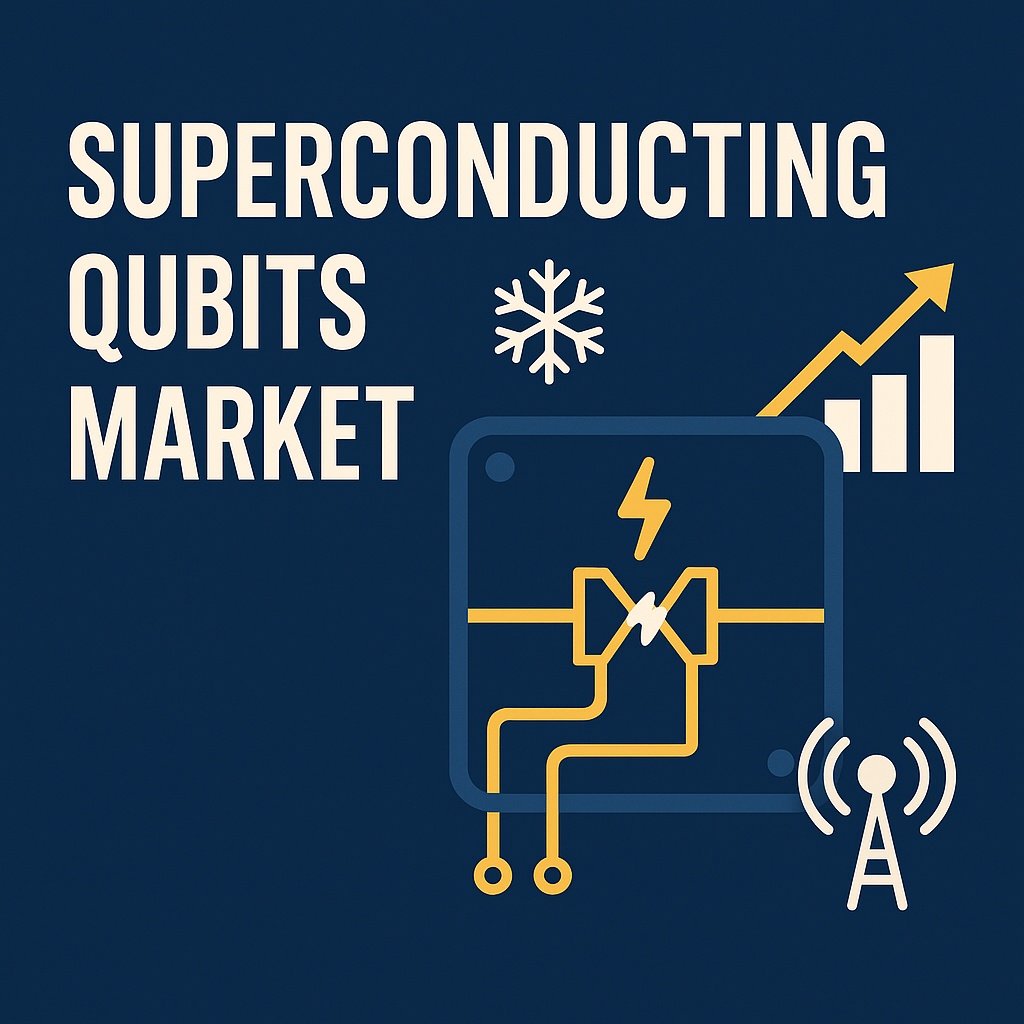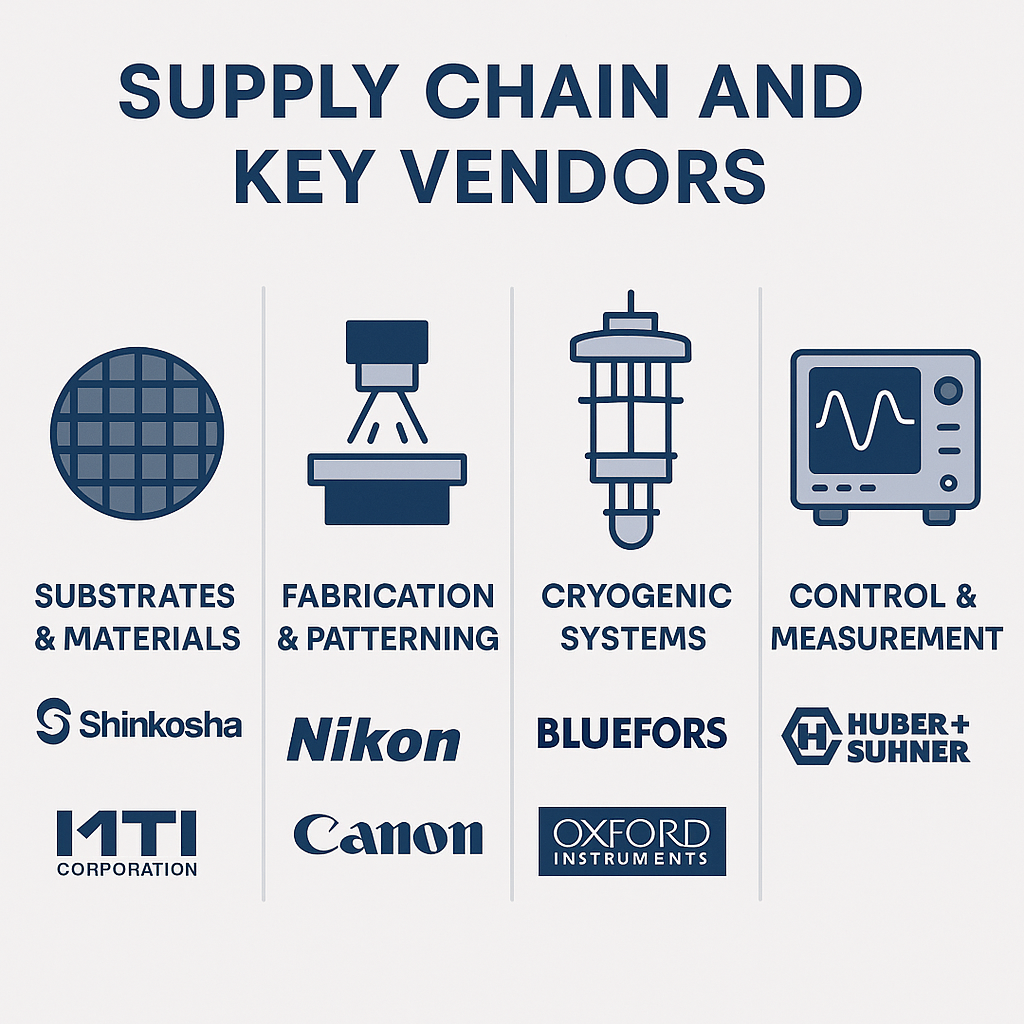
Introduction
Quantum computing is rapidly evolving from a research frontier into a technology with tangible commercial applications. Among the various hardware approaches, superconducting qubits have emerged as one of the leading candidates for building scalable, gate-based quantum computers. Backed by companies like IBM, Google, and Rigetti, superconducting technology has attracted strong venture and government funding, while establishing an industrial supply chain that resembles the semiconductor ecosystem.
In this article, we will examine:
- Market size and leading players in superconducting quantum computing.
- Key technologies that underpin superconducting qubits, explained for a financial and strategic audience.
- The supply chain and critical vendors that make this technology possible.
1. Market Size and Key Players
Global Market Outlook
The global quantum computing market is still relatively small but expanding quickly. Analysts estimate its size at around USD 1.6 billion in 2025, with forecasts ranging from USD 4.2 billion (conservative) to over USD 7 billion (aggressive) by 2030. This corresponds to annual growth rates between 20% and 35% CAGR. Growth is being driven by:
- National investments in quantum research initiatives (U.S., EU, Japan, China).
- Cloud-based access models from major players (IBM, AWS, Microsoft Azure).
- Early commercial demand from pharmaceuticals, finance, and advanced materials companies seeking quantum advantage in simulation and optimization tasks.
Leading Hardware Developers
| Company | Technology Focus | Key Developments | Commercialization Stage |
|---|---|---|---|
| IBM | Superconducting gate-based systems | IBM Quantum Platform; System Two (156 Heron qubits) at RIKEN; roadmap to fault-tolerant quantum computing by 2029 | Market leader; globally deployed; enterprise cloud access |
| Google Quantum AI | Superconducting qubits | First “quantum supremacy” experiment (2019); internal development targeting 1,000+ qubits | Advanced R&D; limited commercial availability |
| Rigetti Computing | Superconducting gate-based systems | Ankaa-2 (84 qubits) accessible via AWS Braket | One of the few gate-based providers available on cloud |
| Oxford Quantum Circuits (OQC) | “Coaxmon” superconducting architecture | Deployed in Equinix Tokyo data centers; Quantum Computing as a Service (QCaaS) | Commercial QCaaS model, expanding in Asia & Europe |
| IQM Quantum Computers | European superconducting processors | Integrated into AWS Braket hardware lineup | Commercial partnerships; strong EU presence |
| D-Wave Systems | Superconducting quantum annealing | Focus on optimization problems; distinct from gate-based race | Commercial annealing systems already in use by enterprises |
2. Key Technologies Behind Superconducting Qubits
Qubit Architecture
The most common design is the transmon qubit, a superconducting circuit that leverages a Josephson junction (a thin insulating barrier between two superconducting films). This non-linear inductive element allows the circuit to act as a quantum two-level system.
Operation Principles
- Microwave Control: Qubits are manipulated by microwave pulses in the gigahertz range.
- Cryogenic Environment: Circuits operate at 10–20 millikelvin, near absolute zero, inside dilution refrigerators.
- Readout: Qubit states are measured via microwave resonators coupled to low-noise amplifiers, detecting the quantum state through photon emissions.
Challenges for Scalability
- Cryogenic CAPEX: Dilution refrigerators cost millions of dollars each and are supplied by a handful of vendors.
- Control Overhead: Each qubit requires dedicated control lines; today’s systems use hundreds of coaxial cables running into the cryostat. This is a major bottleneck.
- Error Rates: Despite advances, gate fidelities remain below the threshold needed for large-scale error correction. Scaling from 100 qubits to millions requires breakthroughs in materials, design, and error mitigation.
For investors, these technical constraints translate into capital intensity and uncertain timelines. However, companies that achieve stable error-corrected architectures could see network effects similar to the semiconductor industry.
3. Supply Chain and Key Vendors

A. Substrates & Materials
- Core Technology: High-purity sapphire or silicon wafers serve as substrates. Superconducting films (aluminum, niobium) are deposited to form Josephson junctions.
- Details: Material purity is crucial; surface defects directly reduce coherence times.
- Key Suppliers: Shinkosha (Japan), MTI Corporation (US), SiCrystal (Germany). For metals and specialty gases: Honeywell (US), Materion (US), JSR (Japan), Linde (Germany), Air Liquide (France).
B. Fabrication & Patterning
- Core Technology: Processes resemble CMOS1 fabrication—photolithography, e-beam lithography, thin-film deposition, and etching.
- Details: Currently, most devices are produced in specialized research fabs (IMEC, university cleanrooms). Partnerships with commercial foundries like TSMC and Samsung are being explored but remain in early stages.
- Key Equipment Vendors: ASML (lithography), Nikon, Canon, Applied Materials, Lam Research, Tokyo Electron.
C. Cryogenic Systems
- Core Technology: Dilution refrigerators maintain 10–20 mK temperatures.
- Details: These are among the most expensive infrastructure items, essential for stable coherence.
- Key Suppliers: Bluefors (Finland, industry leader), Oxford Instruments (UK), Janis Research (US), Cryomech (US, compressors and helium systems).
D. Control & Measurement
- Core Technology: Microwave electronics drive and read qubit states. Ultra-low-noise amplifiers (HEMTs, Josephson Parametric Amplifiers) are used for signal readout.
- Details: Current setups rely on racks of laboratory equipment. Industry is moving toward integrated cryogenic CMOS to reduce cabling and power demands.
- Key Suppliers: Zurich Instruments (Switzerland), Low Noise Factory (Sweden), Huber+Suhner (Switzerland), Keysight Technologies (US), Tektronix (US).
E. Cloud Access & Services
- IBM Quantum Platform and AWS Braket represent the distribution layer, allowing enterprises and researchers to access superconducting hardware remotely. This provides an early revenue stream and creates customer lock-in well before fault-tolerant systems exist.
Conclusion
Superconducting qubits stand at the center of today’s quantum computing race. The market is poised to quadruple in the next five years, with IBM, Google, and Rigetti driving hardware milestones while AWS and IBM monetize through cloud platforms.
From an investment perspective, this technology is capital-intensive but defensible, with high barriers to entry in cryogenics, control electronics, and fabrication. The critical supply chain—stretching from sapphire wafers to dilution refrigerators—already resembles the early semiconductor industry, hinting at how a mature ecosystem might evolve.
While scalability and error correction remain unresolved challenges, the players that overcome these barriers will likely define the quantum computing landscape for decades to come.
- CMOS stands for Complementary Metal-Oxide-Semiconductor, a semiconductor technology used in integrated circuits that offers low power consumption and high integration density. ↩︎